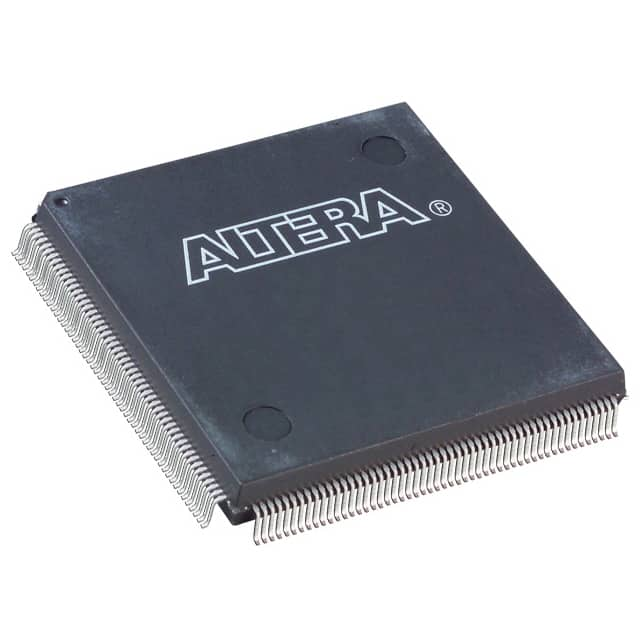Lihat spesifikasi untuk detail produk.

EP1K50QI208-2
Product Overview
Category
EP1K50QI208-2 belongs to the category of programmable logic devices (PLDs).
Use
This product is commonly used in digital circuit design and implementation. It provides a flexible and customizable solution for various applications.
Characteristics
- Programmable: EP1K50QI208-2 can be programmed to perform specific functions according to the user's requirements.
- High Integration: It offers a high level of integration, allowing multiple functions to be implemented on a single device.
- Versatile: This PLD supports a wide range of applications due to its programmability.
- Low Power Consumption: EP1K50QI208-2 is designed to operate efficiently with low power consumption.
Package
The EP1K50QI208-2 comes in a compact package that ensures easy installation and integration into electronic systems.
Essence
The essence of EP1K50QI208-2 lies in its ability to provide a flexible and customizable solution for digital circuit design and implementation.
Packaging/Quantity
This product is typically packaged individually and is available in various quantities depending on the customer's requirements.
Specifications
- Model: EP1K50QI208-2
- Technology: Programmable Logic Device (PLD)
- Package Type: QFP (Quad Flat Package)
- Number of Pins: 208
- Operating Voltage: 3.3V
- Maximum Operating Frequency: 100 MHz
- Logic Elements: 1,536
- Memory Blocks: 48
- I/O Pins: 144
- On-Chip RAM: 36,864 bits
- On-Chip ROM: 4,608 bits
Detailed Pin Configuration
The EP1K50QI208-2 has a total of 208 pins. The pin configuration is as follows:
- Pin 1: VCCIO
- Pin 2: GND
- Pin 3: TCK
- Pin 4: TMS
- Pin 5: TDI
- Pin 6: TDO
- ...
- Pin 208: GND
For a complete pin configuration diagram, please refer to the product datasheet.
Functional Features
- Programmability: EP1K50QI208-2 can be programmed using industry-standard hardware description languages (HDLs) such as VHDL or Verilog.
- High Integration: This PLD offers a high level of integration, allowing for complex digital circuit designs to be implemented on a single device.
- Flexible I/O Configuration: The EP1K50QI208-2 provides a wide range of I/O options, enabling seamless integration with other components and systems.
- On-Chip Memory: With on-chip RAM and ROM, this PLD can store data and instructions, reducing the need for external memory components.
- Low Power Consumption: EP1K50QI208-2 is designed to operate efficiently with low power consumption, making it suitable for battery-powered applications.
Advantages and Disadvantages
Advantages
- Flexibility: EP1K50QI208-2 allows for custom logic designs, providing flexibility in implementing various functions.
- Cost-Effective: By integrating multiple functions into a single device, this PLD reduces the need for additional components, resulting in cost savings.
- Time-Saving: The programmable nature of EP1K50QI208-2 eliminates the need for redesigning circuits, saving time in development cycles.
- Versatility: This PLD can be used in a wide range of applications due to its programmability and high integration.
Disadvantages
- Learning Curve: Utilizing the full potential of EP1K50QI208-2 requires knowledge of hardware description languages and digital circuit design principles.
- Limited Resources: The available logic elements, memory blocks, and I/O pins may be insufficient for complex designs, requiring higher-end PLDs.
Working Principles
EP1K50QI208-2 operates based on the principles of programmable logic. It consists of configurable logic blocks (CLBs), interconnect resources, and I/O elements. The CLBs can be programmed to implement various logic functions, while the interconnect resources facilitate communication between different components. The I/O elements enable interaction with external devices.
The device is programmed using a hardware description language (HDL) such as VHDL or Verilog. The HDL code describes the desired functionality, which is then synthesized into a configuration file that can be loaded onto the EP1K50QI208-2.
Detailed Application Field Plans
EP1K50QI208-2 finds applications in various fields, including:
- Industrial Automation: This PLD can be used to control and monitor industrial processes, providing flexibility and adaptability to changing requirements.
- Communications
Sebutkan 10 pertanyaan dan jawaban umum terkait penerapan EP1K50QI208-2 dalam solusi teknis
Sure! Here are 10 common questions and answers related to the application of EP1K50QI208-2 in technical solutions:
1. What is EP1K50QI208-2? EP1K50QI208-2 is a specific model of Field Programmable Gate Array (FPGA) manufactured by Intel. It is designed for various applications in digital logic design and embedded systems.
2. What are the key features of EP1K50QI208-2? Some key features of EP1K50QI208-2 include 50,000 logic elements, 208-pin Quad Flat Package (QFP), 2.5V core voltage, and support for various I/O standards.
3. What are the typical applications of EP1K50QI208-2? EP1K50QI208-2 can be used in a wide range of applications such as industrial automation, telecommunications, medical devices, automotive electronics, and aerospace systems.
4. How can EP1K50QI208-2 be programmed? EP1K50QI208-2 can be programmed using Hardware Description Languages (HDLs) like VHDL or Verilog. Design files are compiled into a bitstream that can be loaded onto the FPGA.
5. Can EP1K50QI208-2 be reprogrammed? Yes, EP1K50QI208-2 is a reprogrammable FPGA. The configuration can be changed multiple times, allowing for flexibility in design iterations and updates.
6. What tools are available for designing with EP1K50QI208-2? Intel provides Quartus Prime software, which includes a suite of tools for designing, simulating, and programming EP1K50QI208-2. These tools help in creating and optimizing FPGA designs.
7. What is the power consumption of EP1K50QI208-2? The power consumption of EP1K50QI208-2 depends on the specific design and usage. It is recommended to refer to the datasheet and use power estimation tools provided by Intel for accurate power analysis.
8. Can EP1K50QI208-2 interface with other components or devices? Yes, EP1K50QI208-2 supports various I/O standards such as LVCMOS, LVTTL, and differential signaling. It can interface with other components like sensors, memory, communication modules, and more.
9. Are there any limitations or considerations when using EP1K50QI208-2? Some considerations include the available logic resources, I/O pins, and timing constraints. It is important to carefully plan and optimize the design to ensure efficient utilization of the FPGA.
10. Where can I find additional resources and support for EP1K50QI208-2? Intel provides documentation, application notes, reference designs, and a community forum where users can find additional resources and seek support for EP1K50QI208-2. The official Intel website is a good starting point for accessing these resources.

